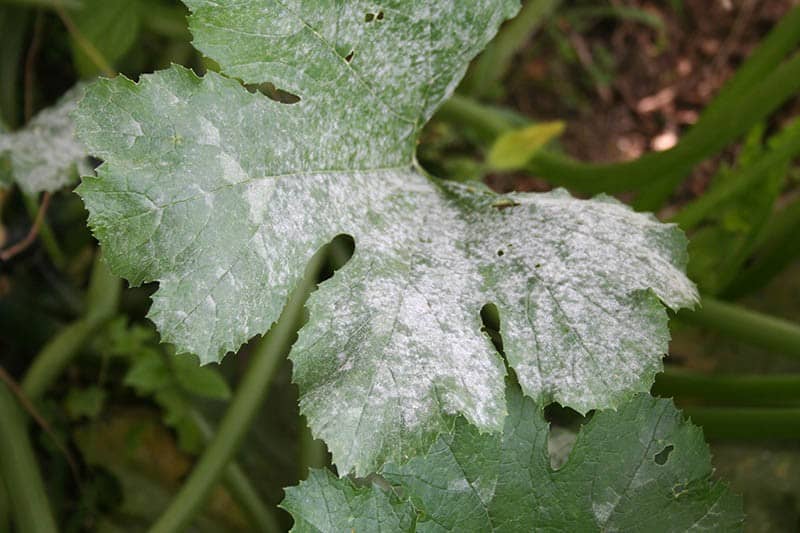Zucchini is an excellent plant to grow for those starting with gardening, especially since they grow well and are generally easy to maintain. Plus, they provide a lot of harvests when cared for well, and who wouldn’t want to enjoy zucchinis during the summer?
But while zucchinis are quick to grow and easy to maintain, sometimes you might see some white spots or discolorations on its large leaves. But what causes white spots on zucchini leaves and how can I get rid of them?
Read on as I show you all about these white spots on zucchini leaves!

What Causes White Spots On Zucchini Leaves?
There isn’t just one reason why you have white spots on zucchini. Here are the following common reasons why you might see white spots or white discolorations on your zucchini plant leaves:
It’s Natural
Zucchini leaves sometimes have natural white spots developing on their leaves’ surfaces. Each leaf has small hairs, which would give the white area a more powdery look. Even when you rub the leaf with your thumb, it won’t remove the white colors, as this is natural.
The natural white blotches don’t have any negative impact on the health and growth of such plants. But when you rub the leaves, do wear gloves as the hair on the leaves and stems may irritate your skin. There is no need to find solutions to natural white spots.
Fungal Spots or Powdery Mildew
If you see white spots that you can rub off, this is most likely powdery mildew. Some zucchini varieties are prone to this kind of fungus compared to others.
You will know if it is powdery mildew if the growth looks white or gray powder on the surface of the upper leaves. This kind of mildew would prevent affected leaves from absorbing any sunlight, weakening it until it yellows and dies.
Minor infestations won’t usually affect the zucchini plant, but if it is severe, it may kill enough leaves to the point it affects the entire plant, failing to fruit or dying off completely.

Downy Mildew
Downy mildew is different from powdery mildew. It would begin as pale green or yellow spots, though some may think it looks a bit white. These types of mildew would follow the veins of the zucchini leaves.
When under dry weather, the foliage may look mottled before the leaves would completely dry out once the spots grow together. It worsens when under wet weather, as it encourages fungus to send out bodies that would rapidly produce gray or white spores, especially once temperatures reach 59 degrees Fahrenheit. Spores can spread in as fast as six hours.
Only zucchini leaves will be infected, but with damaged leaves, it may result in fewer or more disfigured fruits, as well as sunscald fruit from the leaf die-back.
Scarring
Insects, such as thrips, aphids, or whiteflies, have a piercing or rasping mouthparts that can feed on the leaves, sucking its juices or stems. Because of their feeding, it can leave behind scars that look white or pale. It doesn’t harm the plant if the scarring and feeding are very little, but it can be a problem if the pests can cause fungus or disease.
Mosaic Virus
This is a serious virus that can scar on leaves in mottled patterns, continuing to spread when the virus infects even more plant cells. Unfortunately, there isn’t a treatment for infected zucchini plants. You will need to throw the entire plant, and any surrounding plants, away and make sure to prevent the infection from happening again.
Tips on Getting Rid of White Spots on Zucchini Leaves
Now that you’re familiar with why white spots happen on zucchini leaves, what can you do to stop them from spreading? Here are some quick tips to follow:
- If your plant suffers from Downy Mildew, you can treat it by checking your zucchini plant regularly for any growth under its leaves. Make sure that your plants get enough air circulation by spacing them apart, and to water them at ground level instead of overhead to prevent spreading the spores. You can treat mildly infected zucchini plants with a fungicide.
- Prevention is vital when it comes to powdery mildew. To do this, make sure that you plant your zucchini under full sun and with better air circulation, as well as watering it properly. When you see the first signs of powdery mildew growth, use less toxic fungicides to control it, but with severe problems, make sure to apply fungicides.
- If the white spots come from pests scarring on the leaves, then use appropriate pesticides after you have identified the bugs and insects feeding on the leaves. You can also use insecticidal soap and organic-friendly ones to prevent it from poisoning your plants and other beneficial insects.
- If your plants fell victim to the mosaic virus, prevent it from happening again by doing crop rotation, planting at the appropriate time, and to use row covers once the plants begin flowering. When you see insects causing the mosaic virus (cucumber beetles), use neem oil to kill them off.
Do you want to learn more about caring for zucchini plants efficiently? Check out this informative video:
Wrapping It Up
White discoloration on zucchini plants is a common issue, with various causes (and remedies to match them). When you get to the bottom of the white spots, you’ll be able to find ways to get your zucchini plants growing as they should. But if ever they have succumbed to disease or serious fungus, then it’s best to remove them immediately and start planting all over again during the next season.
I hope that this article answers your question, “what causes white spots on zucchini leaves?” Now that you’re familiar with the answer, start identifying the reasons why your zucchini leaves may have white spots, and how to remedy them!